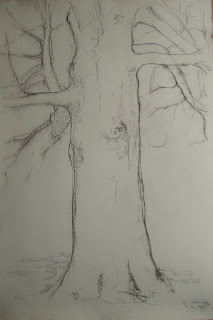
"A tree standing by itself chiefly attracts our attention to the pattern formed throughout its parts. If the foliage is slight, the line of the main stem can be traced from the ground to its dispersal in a haze of twigs at the apex. The balance, the curves, the straight lines that mark its course become our chief concern, and the sparse foliage with its uncompetitive and indefinite forms acts as a foil to display the lines of the stem and its ramifications; we have, in fact, the essential charm that belongs to the winter period. Any single object by its isolation attracts attention." - Rex Vicat Cole, The Artistic Anatomy of Trees, 1915
During winter months bare trees show their structure, their anatomy. Foliage creates shapes and effects of its own but what fascinates me is the bare bones of the thing. Like a skeleton or the underside of a bridge, it's what makes it what it is --- its mass and form. When drawing or painting trees, it is important to understand and represent basic structure. Trunks, branches, and twigs are anatomical elements. When drawing or painting human anatomy, one wants to give arms the right shape, torsos the right proportion. It's not really any different when faced with a tree. The representation of parts --- their size, shape, proportions, and weight, is a matter of repeated study.
It was a cold day last week when I worked on this drawing in Prospect Park. My fingers were hurting but I got a little closer to the right balance of parts than I usually do. But where the trunk terminates at the ground seems flat so I'll have to go find this tree again, if I can. If not, another will do.